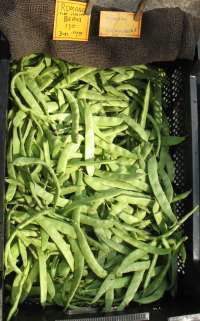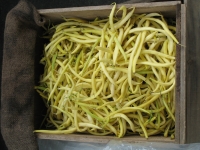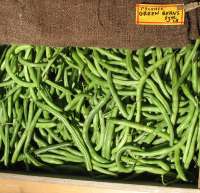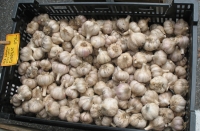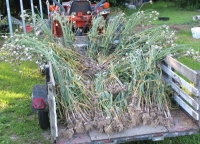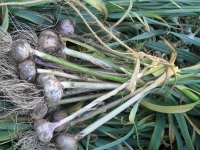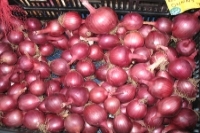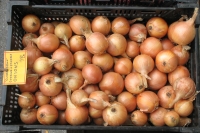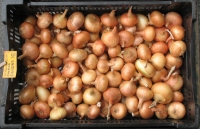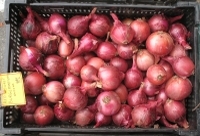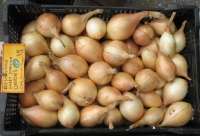![[Snakeroot Organic Farm logo]](pix/sof.gif)

…and now for something completely different…
At dawn
Canoe bow waves are quickly lost
on the shoreside
But go on out of sight
on the lake side.
-1986
The constant swish-swish of skis
On a day long ski.
The constant swish-swish of wiper blades
On a day long drive.
-1990
My dog, trotting barefoot
Steps on a garden slug
And thinks
Nothing of it.
-1999
Word spreads quickly
as I approach the pond.
All becomes quiet.
-1997
Hidden in the vines
a large warted cucumber
jumps out of reach.
A toad!
-1997
Delicate puffs
of marshmallow snow
carefully perched
on a branch,
await the trigger of my hat
to melt their way down my back.
-2010
Deep in the tomato jungle
Fruits of yellow, purple and red
Tell of their readiness
To go to market.
-2010
Sugarin' Chores
Snowflakes hurry through my flashlight beam,
As my boots knead new snow with spring mud,
On my nightly Hajj to keep the boil alive,
For as long as possible until the dawn,
To match the power of the flowing sap,
With my meager evaporator and will.
The prize at the finish line are jars of syrup
And Spring.
-2013
|
Fresh
Vegetables
~ Our Specialty ~
|
![[Snakeroot Organic Farm]](pix/sof.gif)
on the Snakeroot Road in Pittsfield, Maine
27 Organic Farm Road, Pittsfield ME 04967,
ph (207) 487-5056
Gardeners to the public since 1995.
|
Click on photos to enlarge.
Items marked with a * are also available from us as seedlings in May and June.
Also see our Fresh Herbs, Fresh Fruit, and our Perennials page.
|
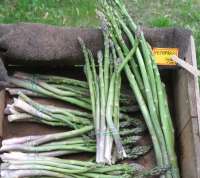 Asparagus, mid May to mid June. We have a single two hundred foot bed planted in the spring
of 2004. As a result, we bring a fairly small quantity of asparagus to each market during its season.
Asparagus, mid May to mid June. We have a single two hundred foot bed planted in the spring
of 2004. As a result, we bring a fairly small quantity of asparagus to each market during its season.
|
|
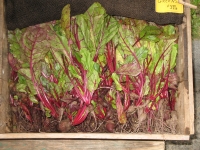 Beet Greens, early May thru September. Beet greens are one of the crops we grow in our greenhouses for the first early
crop in May. By June, they are coming from the field. We do continuous plantings of beet greens throughout the season in order
to have a steady supply. We plant Early Wonder Tall Top from organic seed.
Beet Greens, early May thru September. Beet greens are one of the crops we grow in our greenhouses for the first early
crop in May. By June, they are coming from the field. We do continuous plantings of beet greens throughout the season in order
to have a steady supply. We plant Early Wonder Tall Top from organic seed.
|
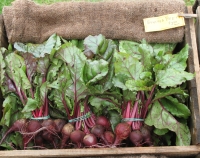 Bunched Beets, late June thru September. These are our beet greens that have grown up and begun to produce beets. Early Wonder Tall Top makes wonderful bunched beets, whose greens remain tender even with two inch beets attached.
Bunched Beets, late June thru September. These are our beet greens that have grown up and begun to produce beets. Early Wonder Tall Top makes wonderful bunched beets, whose greens remain tender even with two inch beets attached.
|
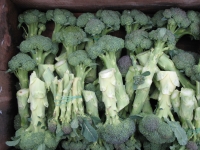 Broccoli*, early June to mid November. We grow several varieties of broccoli in a succession of plantings in order to extend the harvest season as much as possible. Our favorites are Pacman and Gypsy, but we are always trying a new variety or two. After the main heads are cut, we continue to cut side shoots for several weeks.
Broccoli*, early June to mid November. We grow several varieties of broccoli in a succession of plantings in order to extend the harvest season as much as possible. Our favorites are Pacman and Gypsy, but we are always trying a new variety or two. After the main heads are cut, we continue to cut side shoots for several weeks.
|
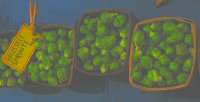 Brussels Sprouts*, mid September to mid November. We just began growing Brussels sprouts in
2007 and are quite pleased with the response. We'll be expanding our plantings each year until the
demand is satisfied.
Brussels Sprouts*, mid September to mid November. We just began growing Brussels sprouts in
2007 and are quite pleased with the response. We'll be expanding our plantings each year until the
demand is satisfied.
|
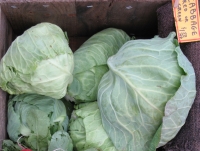 Cabbage*, mid June to mid November. We grow two kinds of green cabbage, the round Primax and the pointed Jersey Wakefield, and one red cabbage, round Ruby Perfection.
Cabbage*, mid June to mid November. We grow two kinds of green cabbage, the round Primax and the pointed Jersey Wakefield, and one red cabbage, round Ruby Perfection.
|
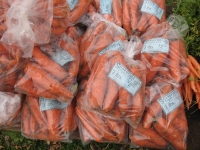
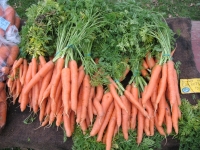 Carrots, bunched, bagged and loose, early May thru November. To get that early crop of bunched carrots in May, we start Mokum carrots -- a very sweet early variety -- in our greenhouse in February. These are usually sold out before the field carrots are ready in mid June from an early April planting. By mid summer, we begin offering carrots in 3 lb. bags as well as bunches. Bolero and Nelson are the other mainstay varieties we grow, including a large late planting in early July for fall harvest. We generally have carrots available at the farm all winter long, and offer overwintered carrots in May along with our bunched greenhouse carrots.
Carrots, bunched, bagged and loose, early May thru November. To get that early crop of bunched carrots in May, we start Mokum carrots -- a very sweet early variety -- in our greenhouse in February. These are usually sold out before the field carrots are ready in mid June from an early April planting. By mid summer, we begin offering carrots in 3 lb. bags as well as bunches. Bolero and Nelson are the other mainstay varieties we grow, including a large late planting in early July for fall harvest. We generally have carrots available at the farm all winter long, and offer overwintered carrots in May along with our bunched greenhouse carrots.
|
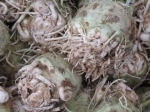 Celeriac*, available September to May, has been cultivated especially for its edible root. Celeriac is very popular in Europe and Russia, actually more popular than stalk celery. It can be stored along with carrots and other root vegetables, or up to a month in the refrigerator. Celeriac is high in carbohydrates, vitamin C, phosphorous, and potassium. Celeriac leaves and stalks are edible and can be used to flavor soup stalks, but use sparingly as they are more potent than common celery. Celeriac can also be eaten raw, grated into a salad, or used for dipping. Use in soups, stews, or an old standby is to mash with potatoes. Buying and preparing: If possible, buy smallish bulbs of celeriac. The flesh discolors when exposed to light, so as soon as peeled, sliced, or diced, plunge it into bowl of water with lemon juice.
Celeriac*, available September to May, has been cultivated especially for its edible root. Celeriac is very popular in Europe and Russia, actually more popular than stalk celery. It can be stored along with carrots and other root vegetables, or up to a month in the refrigerator. Celeriac is high in carbohydrates, vitamin C, phosphorous, and potassium. Celeriac leaves and stalks are edible and can be used to flavor soup stalks, but use sparingly as they are more potent than common celery. Celeriac can also be eaten raw, grated into a salad, or used for dipping. Use in soups, stews, or an old standby is to mash with potatoes. Buying and preparing: If possible, buy smallish bulbs of celeriac. The flesh discolors when exposed to light, so as soon as peeled, sliced, or diced, plunge it into bowl of water with lemon juice.
|
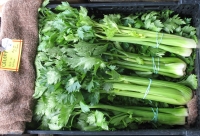 Celery*, both red and green stalked, available July to November. Our celery has a heartier flavor than store-bought types, and it always comes with leaves attached to you can use them in soups, salads or to dry for celery flakes. The red-stalked variety is a cross between the regular green type (Ventura variety) and a large red very stong flavored celery. The result is a slightly stronger flavored red celery.
Celery*, both red and green stalked, available July to November. Our celery has a heartier flavor than store-bought types, and it always comes with leaves attached to you can use them in soups, salads or to dry for celery flakes. The red-stalked variety is a cross between the regular green type (Ventura variety) and a large red very stong flavored celery. The result is a slightly stronger flavored red celery.
|
Chard See Swiss chard.
|
Cukes*, picklers and slicers, July thru early September. We always have an early planting of greenhouse cucumbers available in early June and bring these to market until our field cukes are ready in mid July. For slicers we grow General Lee, Olympian, and several Marketmore strains. For picklers we grow Alibi and several others. We offer discounts on both picklers and slicers in pecks and bushels during the height of the season.
|
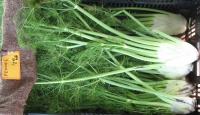 Fennel, mid July thru late October. Anise-flavored herb and vegetable. Both the bulb and leaves are
used to flavor soups and stirfries.
Fennel, mid July thru late October. Anise-flavored herb and vegetable. Both the bulb and leaves are
used to flavor soups and stirfries.
|
|
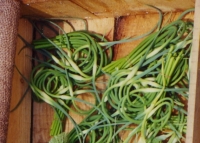 Garlic Scapes, mid June to mid July. These are the curly-cue tops of the rocambole (stiff-neck) garlic plants with real garlic
flavor that can be eaten any way you'd use garlic. We get an extra early crop by growing some of our garlic in a greenhouse. A
wonderful pesto can be made from them, here is a recipe. We harvest about one
fifth of our scapes for market, and the rest we let grow into bulbils.
Garlic Scapes, mid June to mid July. These are the curly-cue tops of the rocambole (stiff-neck) garlic plants with real garlic
flavor that can be eaten any way you'd use garlic. We get an extra early crop by growing some of our garlic in a greenhouse. A
wonderful pesto can be made from them, here is a recipe. We harvest about one
fifth of our scapes for market, and the rest we let grow into bulbils.
|
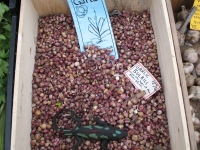
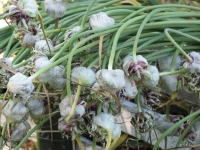 Garlic Bulbils, October. These are the pea to chickpea sized garlics that grow in the garlic scapes that we leave on
the plant to mature. They can be used to grow garlic grass all winter long in a flower pot, or can be planted in the garden to
produce garlic rounds by mid July. Learn how we use bulbils here.
Garlic Bulbils, October. These are the pea to chickpea sized garlics that grow in the garlic scapes that we leave on
the plant to mature. They can be used to grow garlic grass all winter long in a flower pot, or can be planted in the garden to
produce garlic rounds by mid July. Learn how we use bulbils here.
|
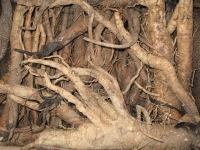 Gobo (Japanese Burdock) root, October thru April. Gobo, or burdock root, is a popular vegetable in Asia and among
folks on a macrobiotc diet. Called "the poor man's ginseng", gobo is renowned for it's health giving properties. We
grow the Takinogawa varitety, originally from Johnny's, but we have been saving our own seeds for years.
Gobo (Japanese Burdock) root, October thru April. Gobo, or burdock root, is a popular vegetable in Asia and among
folks on a macrobiotc diet. Called "the poor man's ginseng", gobo is renowned for it's health giving properties. We
grow the Takinogawa varitety, originally from Johnny's, but we have been saving our own seeds for years.
|
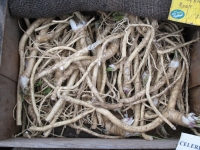 Horseradish, May through November.
Horseradish, May through November.
|
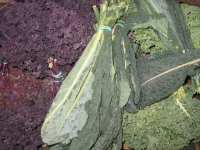 Kale*, mid July to December. Altho some people prefer the sweeter taste of kale once it has been frosted in the fall,
we find it is welcome in the markets as soon as we can harvest it midsummer. We grow, as pictured here, red
(Redbor), smooth leaf (Lacinato) and green (Winterbor) kales.
Kale*, mid July to December. Altho some people prefer the sweeter taste of kale once it has been frosted in the fall,
we find it is welcome in the markets as soon as we can harvest it midsummer. We grow, as pictured here, red
(Redbor), smooth leaf (Lacinato) and green (Winterbor) kales.
|
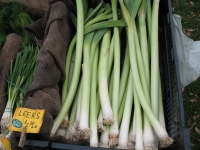 Leeks*, September thru Winter. The leek is the national flower of Wales, and popular vegetable in potato leek soup.
Leeks are in the onion family and can be used wherever onions are called for. Harvest begins in September for market, and by
November they are all harvested and stored for winter.
Leeks*, September thru Winter. The leek is the national flower of Wales, and popular vegetable in potato leek soup.
Leeks are in the onion family and can be used wherever onions are called for. Harvest begins in September for market, and by
November they are all harvested and stored for winter.
|
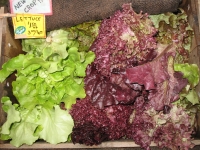 Lettuce*, early May thru November. Lettuce is part of our market display for the entire season, altho the individual
varieties change with the heat or cold of the growing conditions. Buttercrunch, romaine, oakleaf and boston types are the loose head
varieties we grow in various shades of red and green.
Lettuce*, early May thru November. Lettuce is part of our market display for the entire season, altho the individual
varieties change with the heat or cold of the growing conditions. Buttercrunch, romaine, oakleaf and boston types are the loose head
varieties we grow in various shades of red and green.
|
Baby Lettuce Mix, Early May to November. A mix of red and green varieties planted closely together, Baby Lettuce Mix
is harvested when very young, long before heads begin to form, resulting in extreme tenderness of the leaves. With these you
can make delicate salads, sometimes made by mixing in Spicy Greens,
|
|
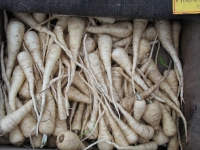 Parsnips, September through May. We start digging parsnips in September, and continue digging them as we go to market
until late October, when we dig our winter's supply. We usually leave about a quarter of the parsnip patch to dig in April so
we'll have some at the farmers' markets May.
Parsnips, September through May. We start digging parsnips in September, and continue digging them as we go to market
until late October, when we dig our winter's supply. We usually leave about a quarter of the parsnip patch to dig in April so
we'll have some at the farmers' markets May.
|
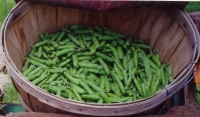 Peas, late June to mid July. To extend the pea season we grow early peas with shorter pods (usually
Dakota varitey) and later peas with longer pods (Green Arrow variety).
Peas, late June to mid July. To extend the pea season we grow early peas with shorter pods (usually
Dakota varitey) and later peas with longer pods (Green Arrow variety).
|
Peas, Edible Pod See Snow peas or Sugar Snap Peas.
|
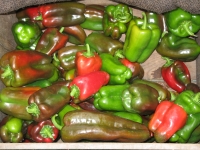 Sweet Peppers*, early August to late October. Our sweet peppers are green, turning to red as they mature, and we grow both the regular
bell peppers and the long Italian peppers.
Sweet Peppers*, early August to late October. Our sweet peppers are green, turning to red as they mature, and we grow both the regular
bell peppers and the long Italian peppers.
|
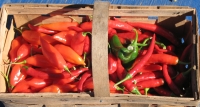 Hot Peppers*, Habañeros, cayenne & jalapeños, mid August thru November. We grow these in large pots in our greenhouse during
the summer, where the enjoy the heat of high summer. What's left over after markets close we dry and package for sale at
market the following season.
Hot Peppers*, Habañeros, cayenne & jalapeños, mid August thru November. We grow these in large pots in our greenhouse during
the summer, where the enjoy the heat of high summer. What's left over after markets close we dry and package for sale at
market the following season.
|
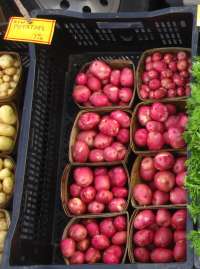
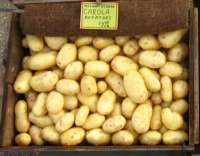 Potatoes*, yellow-fleshed varieties, July thru November. Our early potatoes are Red Gold, a red skinned yellow flesh
variety, and we start digging these in late June or early July. By September we have the yellow fleshed German Carola,
probably the finest potato grown. Both have a smooth and creamy texture unlike any regular potato, yellow or
white. Currently we sell out of both varieties about six weeks after we begin digging them, so we are planning
to plant more.
Potatoes*, yellow-fleshed varieties, July thru November. Our early potatoes are Red Gold, a red skinned yellow flesh
variety, and we start digging these in late June or early July. By September we have the yellow fleshed German Carola,
probably the finest potato grown. Both have a smooth and creamy texture unlike any regular potato, yellow or
white. Currently we sell out of both varieties about six weeks after we begin digging them, so we are planning
to plant more.
|
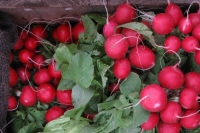 Radishes, early May to late October. We primarily grow round red radishes using Champion as our favorite variety.
Radishes, early May to late October. We primarily grow round red radishes using Champion as our favorite variety.
|
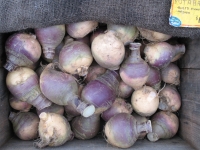 Rutabagas, mid August thru November. Rutabagas are in the cabbage family, while their cousins turnips are in the
radish family. Rutabagas have necks between the root and the leaves, while turnips do not. Rutabagas also are slightly yellow
fleshed, and are sometimes refered to as a Swede Turnip. Can be used wherever fall turnips are used, such as in boiled dinners
or steamed and mashed as a side vegetable.
Rutabagas, mid August thru November. Rutabagas are in the cabbage family, while their cousins turnips are in the
radish family. Rutabagas have necks between the root and the leaves, while turnips do not. Rutabagas also are slightly yellow
fleshed, and are sometimes refered to as a Swede Turnip. Can be used wherever fall turnips are used, such as in boiled dinners
or steamed and mashed as a side vegetable.
|
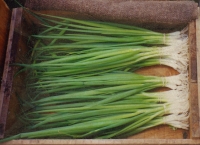 Scallions*, mid June thru September. These are a non-bulbing onion with a delicate familiar onion
flavor. Scallions may be used from tip to tail, and make a welcome addition to salads, stir fries and omlettes. We usually
put in a late planting to overwinter so we will have scallions at market in early May and June.
Scallions*, mid June thru September. These are a non-bulbing onion with a delicate familiar onion
flavor. Scallions may be used from tip to tail, and make a welcome addition to salads, stir fries and omlettes. We usually
put in a late planting to overwinter so we will have scallions at market in early May and June.
|
Snow Peas, July. The original edible podded peas. Oregon Giant are our favorite variety of snow pea,
as they are large and remain tender even when the peas begin to develop. Edible podded peas mean you eat the whole thing,
shell and all, after breaking off the stem and pulling down any string. Great in stir fries and salads.
|
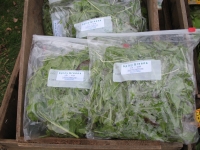 Spicy Greens, May to November. A mixture of mizuna, arugula and red and green mustard, spicy greens are grown and
harvested all together, and we begin planting them in the winter greenhouses and have them ready for our farmers' markets in May.
To assure a continuous supply, they need to be planted every two weeks during the warm part of the growing season. Some like
these as the sole green in a salad, others mix them with lettuce for a more flavorful salad.
Spicy Greens, May to November. A mixture of mizuna, arugula and red and green mustard, spicy greens are grown and
harvested all together, and we begin planting them in the winter greenhouses and have them ready for our farmers' markets in May.
To assure a continuous supply, they need to be planted every two weeks during the warm part of the growing season. Some like
these as the sole green in a salad, others mix them with lettuce for a more flavorful salad.
|
Spinach, May & June and again in September through November. Spinach does not like hot weather, so Swiss chard becomes a
subsititute in July and August. We plant spinach in our greenhouses in November to have spring spinach even before the markets
open in May. Each spring planting of spinach provides only a few weeks of harvest, so we do several spring plantings. Spinach
for fall harvest is planted starting in early August and appears at market in September thru November.
|
Sugar Snap Peas, July. Round filled out pods and you eat the whole thing.
|
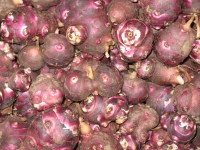 Sunchokes, October to May. Our sunchokes are the red-skinned variety, originally from Nova Scotia. One of a
handful of vegetables native to North America, they were described by Samuel Champlain when he visited what is now
Chatham, Massachusetts in 1605. Also called Jerusalem artichokes, sunchokes are not from Jerusalem nor are they
related to artichokes. In fact they are in the sunflower family, as is apparent during the growing season. Each
fall we harvest enough for winter, then dig the rest of the patch in spring.
Sunchokes, October to May. Our sunchokes are the red-skinned variety, originally from Nova Scotia. One of a
handful of vegetables native to North America, they were described by Samuel Champlain when he visited what is now
Chatham, Massachusetts in 1605. Also called Jerusalem artichokes, sunchokes are not from Jerusalem nor are they
related to artichokes. In fact they are in the sunflower family, as is apparent during the growing season. Each
fall we harvest enough for winter, then dig the rest of the patch in spring.
|
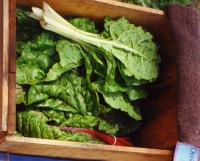 Swiss Chard*, early July to November. We offer three varieties of chard, the traditional white
stem, the red stem, and the yellow stem. The white stem varities have the broadest stem and are the most
cold tolerant, finally succombing to frosts in early November. The red and yellow varieties usually taper off a few
weeks prior to the white, being a little more cold-sensitive.
Swiss Chard*, early July to November. We offer three varieties of chard, the traditional white
stem, the red stem, and the yellow stem. The white stem varities have the broadest stem and are the most
cold tolerant, finally succombing to frosts in early November. The red and yellow varieties usually taper off a few
weeks prior to the white, being a little more cold-sensitive.
|
|
Tomatoes*, late June thru November. Three thousand plants of thirty varieties is typical of
our tomato planting. We grow both heirlooms and hybrids in colors of orange, yellow, pink, purple and
red; and round, long, paste, and pear shaped and round cherry tomatoes. All are grown on the ground
with a mulch of leaves delivered to us the previous fall. From
mid August to early October we also offer as canning tomatoes those that are overripe or have
cosmetic defects. We mix all varieties in our canners unless we have a request for a certain type.
Our specialty tomatoes are all heirlooms: Hogheart (second from top), the long Italian red paste
tomato that's also great for sandwiches; Pruden's Purple (second from bottom), the big round pink ugly
tomato that rivals Brandywine for flavor; Frosty's Heart (bottom right), a pink heart-shaped Italian
heirloom with a smooth silky texture; and our own Snakeroot Golden Arrow (top), a dark yellow long
paste tomato we are in the process of selecting for greater length. We also grow a selection of
yellow sandwich and salad tomatoes, such as the Yellow Brandywine, Valencia and others (below center).
Unripe green tomatoes (below left) are available for about a month starting in early September. All
of our major heirloom varieties are grown from seed we have grown ourselves. Every year we test
several new varieties to see how they grow for us and how our customers like them.
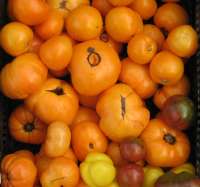
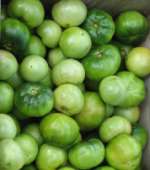
|
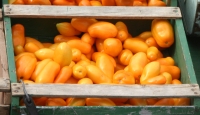
| 
| 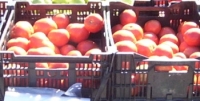
| 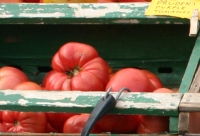
| 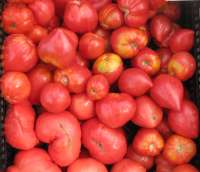
|
|
|
Cherry Tomatoes*, mid July to late October. We grow five different varieties of cherry tomatoes; four of them are
heirlooms (Yellow Pear, Red Pear, Gardener's Delight, and Black Cherry) and one is a hybrid (Sungold). We pack pints mixing
the varieties randomly, and at the height of the season we also bring them in by the bushel so folks can create their own pints any
way they like. Then it's "Nibbler's Heaven" for cherry tomato lovers. All of our cherry tomatoes are indeterminates
grown on trellises in two of our greenhouses. This means we have fewer split tomatoes after heave rains, and it
means we have both earlier and later cherry tomatoes than if they were grown outdoors. |
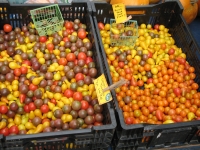
|  |
|
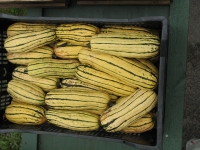 Winter Squash*, late August to December. Delicata (shown), Acorn, Butternut, Buttercup, Sunshine, and the heirloom New England Long Pie Pumpkin.
Winter Squash*, late August to December. Delicata (shown), Acorn, Butternut, Buttercup, Sunshine, and the heirloom New England Long Pie Pumpkin.
|
Zucchini* & Summer Squash*, early July thru early September. We grow both heirloom and hybrid zucchini, and hybrid
summer squash, including the Johnny's introduction Zephyr, a delicious long yellow summer squash with a green tip.
|
|
![[Snakeroot Organic Farm logo]](pix/sof.gif)



